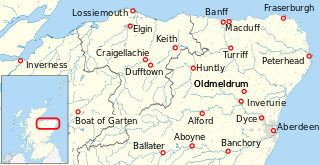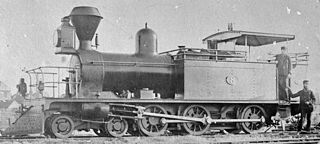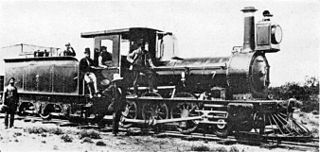
4-4-0 is a locomotive type with a classification that uses the Whyte notation for the classification of steam locomotives by wheel arrangement and represents the arrangement: four leading wheels on two axles, four powered and coupled driving wheels on two axles, and a lack of trailing wheels. Due to the large number of the type that were produced and used in the United States, the 4-4-0 is most commonly known as the American type, but the type subsequently also became popular in the United Kingdom, where large numbers were produced.

The Great Western Railway Metropolitan Class2-4-0T broad gauge steam locomotives with condensing apparatus were used for working trains on the Metropolitan Railway. The equipment was later removed, though the class continued to work suburban trains on GWR lines in London. The class was introduced into service between June 1862 and October 1864, and withdrawn between June 1871 and December 1877.
The MGWR Class D-bogie were first 4-4-0 operated by the Midland Great Western Railway (MGWR) of Ireland. They were rebuilt from MGWR Class D 2-4-0 locomotives in 1900/01 with the intention to use them on the Dublin-Sligo mainline but they proved underpowered for this work and were allocated to more suitable work around Mayo and Achill. This led to their nicknames of Mayo Bogies or Achill Bogies. Following the merger of the MGWR into Great Southern Railways (GSR) they also became designated class 530 or D16.

Under the Whyte notation for the classification of steam locomotives, 2-4-0 represents the wheel arrangement of two leading wheels on one axle, four powered and coupled driving wheels on two axles and no trailing wheels.
The MGWR Classes F, Fa and Fb are a group of similar classes of 0-6-0 steam locomotives of the Midland Great Western Railway of Ireland which were designed and built between 1921 and 1924. The locomotives could be used to handle goods and also for passenger traffic.
The Midland Railway Johnson 0-6-0 were a class of locomotives serving Britain's Midland Railway system in the late 19th and early 20th centuries. Between 1875 and 1908 the Midland Railway, under the control of locomotive superintendents Samuel Waite Johnson and Richard Deeley, ordered 935 goods tender engines of 0-6-0 type, both from the railway's own shops at Derby and various external suppliers. Although there were many variations between different batches both as delivered and as successively rebuilt, all 935 can be regarded as a single series, one of the largest classes of engine on Britain's railways. The locomotives served as late as 1964, but none of them now survive.
The Federated Malay States Railways (FMSR) was a consolidated railway operator in British Malaya during the first half of the 20th century. Named after the then recently formed Federated Malay States in 1896 and founded five years after the formation of the federation, the company acquired various railways that were developed separately in various parts of Malaya, and oversaw the largest expansion and integration of the colonial rail network encompassing the Federated Malay States, the Unfederated Malay States and the Straits Settlements, with lines spanning from Singapore in the south to Padang Besar in the north.
The L&YR Class 2 (Aspinall) was a class of 4-4-0 steam locomotives of the Lancashire and Yorkshire Railway.

The locomotives of the Great North of Scotland Railway were used by the Great North of Scotland Railway to operate its lines in the far north-east of the country. The railway opened in 1854 with just five 2-4-0 steam locomotives, and from 1862 it used 4-4-0 exclusively as the wheel arrangement for its tender locomotives. When it expanded by amalgamation in 1866, it inherited some locomotives from these companies. It purchased most of its locomotives, although building a small number itself, two at its first works at Kittybrewster, and ten later at Inverurie Locomotive Works.

The WAGR B class was a class of 4-6-0T tank locomotives operated by the Western Australian Government Railways (WAGR) between 1884 and 1959.

The Cape Government Railways 1st Class 2-6-0 of 1876 by Beyer, Peacock and Avonside was a South African steam locomotive from the pre-Union era in the Cape of Good Hope.

The Cape Government Railways 1st Class 2-6-0 of 1876 by Kitson was a South African steam locomotive from the pre-Union era in the Cape of Good Hope.
The Midland Great Western Railway (MGWR) C Class was a class of 4-4-0 locomotives designed and built at Broadstone by Edward Cusack between 1909 and 1915 using parts obtained from Kitson and Company. They replaced the earlier 7-12 class. The class survived through the Great Southern Railways (GSR) era from 1925-1944 and were withdrawn in the 1950s under Córas Iompair Éireann.

The MGWR Class L/Lm/Ln were Midland Great Western Railway (MGWR) 0-6-0 locomotives. Following merger of the MGWR into the Great Southern Railways (GSR) in 1925 these locomotives still generally kept to their former area, as did the equivalent GS&WR Class 101 standard goods to their former area. Whereas Class 101 was noted for some working of branch line passenger trains this was less likely for the MGWR class L; however they were noted for passenger mixed working on the Clifden and Ballaghaderreen branch lines.

The Midland Great Western Railway (MGWR) A Class, later Inchicore Class D5, consisted of 6 4-4-0 express passenger locomotives built at Broadstone Works in the period 1902-1905. The largest express passenger locomotive in Ireland for a short while after introduction they were used on the MGWR's flagship services to Galway with most surviving until the 1950s albeit on less prestigious work.
The Great Southern Railways (GSR) 222/234 Classes 0-6-0 originated from 2 batches of 3 locomotives built for the Waterford, Limerick and Western Railway (WLWR) by Kitson with a contract payment dispute resulting in the final two members going to Midland Great Western Railway becoming MGWR Class W.

Midland Great Western Railway (MGWR) Classes 1,2,3,4,5 and 13 were 2-2-2 locomotives acquired over the period 1847-1862 serving the railway in its formative years.
Midland Great Western Railway (MGWR) Classes 12, 14, 15, 16 and 19 were 36 0-4-2 locomotives acquired in 5 batches over the period 1861-1872. The first 0-4-2s were introduced by the Locomotive Superintendent Joseph Cabry, and his successor Robert Ramage in 1863 also seemed to favour the type. After Martin Atock succeeded in 1872 there were no more orders of the type due to generally poor timekeeping.
Midland Great Western Railway (MGWR) Classes 6,8,10,11,17 and 18 were 2-4-0 locomotives introduced in the period 1852-1870. The 22 locomotives were spread across 6 different manufacturers and all were withdrawn in the decade between 1880 and 1890 though some donated parts to other builds at Broadstone Works.

The Lancashire and Yorkshire Railway (L&YR) Barton Wright 4-4-0 was four-coupled eight-wheeled bogie express engine which entered service in 1880.











